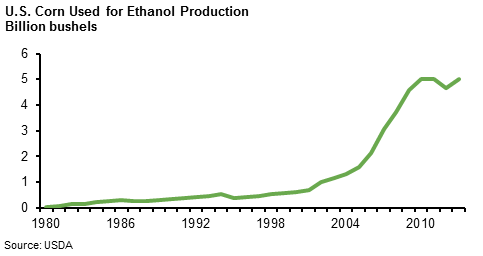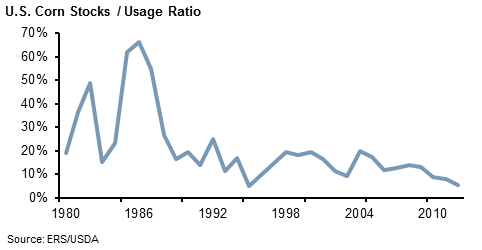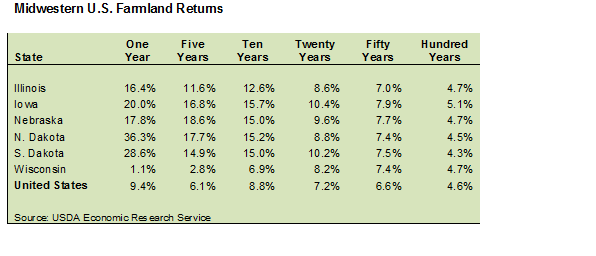Everyone has to eat in order to survive and the production of almost all food can be traced back to farmland around the world in some way. Demand is growing for farmland as the world's population and global needs for food increase. What many don't realize is that the supply of farmland is not changing, thus creating a severe imbalance in the supply and demand of farmland.
An investment in farmland over the long-term will provide a steady stream of income and capital gains due to the increasing global demand for agricultural commodities, driven by the rising world population, rapid growth in emerging markets, and continued demand for ethanol and biofuels. Demand for agricultural commodities is outpacing supply, positioning farmland for long-term appreciation.
In brief, the following factors are important in driving the fundamental investment rationale for farmland investments:
• Cash Returns – farmland is a performing asset, generating modest cash returns of 4-6%, depending on location and crop.
• Land Scarcity – there are approximately 3.5 billion acres of arable land in the world with the potential for adding a mere 20% over the next 20 years.
• Food Demand – as incomes rise, demand for proteins will increase with corresponding increases in the need for feed grains. Demand is growing in developing countries: The United States Department of Agriculture (USDA) expects exports to rise to as much as $167 billion in 2021 from $82 billion in 2007.
• Bio-fuels – agriculture and energy markets are now bound together by federal mandates for renewable fuels. The USDA estimates that 40.5% of the U.S. corn crop was used for ethanol in 2011 and 43.1% was used in 2013.
• Declining Inventories Worldwide – inventories of grains, as measured by “Stocks to Use” ratios have been trending down in many countries. In the U.S., there is a roughly 35-day supply of corn. In China, declining stocks has created the potential for increasing imports of corn.
• Low Farm Sector Debt Levels – the U.S. farm sector has a healthy balance sheet. Current debt to assets ratios are at 40-year lows and 78% of Iowa farmland is free of debt.
• U.S. Infrastructure – from transportation and storage networks to the stability of government programs and the know-how at U.S. universities, the U.S. farm sector has the ability to grow and efficiently market large volumes of feed and foodstuffs.
• Inflation Hedge – many economists expect inflation in the longer term as large federal deficits and the Federal Reserves’ easy money policy will create conditions for high inflation. Farmland is highly correlated to inflation and negatively correlated to most other financial asset classes.
• Resource Conservation – agriculture production must be managed as a sustainable resource to feed the world’s growing population. Water is a vital resource and is a limiting factor for irrigated agriculture throughout the world.
• Sustainable Asset – farmland improves in productivity over time when well-managed.
World Population Growth:
According to the U.S. Census Bureau, approximately 7.0 billion people inhabited the earth in 2012, compared to 1.7 billion in 1900 and 5.8 billion in 1985. The rate of population growth is not expected to temper as the United Nations (U.N.) estimates the world’s population will likely reach 9.2 billion in 2050. The majority of population growth is expected to originate in emerging economies with developed countries remaining stable. 
In order to feed the world’s growing and longer-living population, agricultural output will need to double by 2050 according to the U.N.’s Food and Agriculture Organization (FAO). This will be a daunting goal to accomplish as agricultural resources are already strained. In the last decade, agricultural output has grown by 2.4% annually. In order to double agricultural output by 2050, output must increase at 3.4% per year.
Historical grain production statistics suggest reaching this goal will be difficult. In 9 of the last 10 years, the global consumption of grain has outpaced production according to the USDA. To meet future demand, experts are predicting that global agriculture will need to produce more food in the next 50 years than what was produced during the previous 10,000 years, putting more and more pressure on future farmers and the land they use to produce our food.
Agriculture Exports:
The reason food demand is growing faster than population growth is the development of middle classes in emerging markets, due to above average Gross Domestic Product (GDP) growth. The Brookings Institution estimates that by 2021, China’s middle class could grow to over 670 million, compared to only 150 million in 2010. Economists have long shown that as GDP rises, so does the consumption of animal protein as a percentage of diet. As emerging economies continue to develop, there will be a transfer from a grain-based diet to a protein-based diet.
Roughly half the increase in global calorie consumption in the past decade has been a result of higher meat consumption according to the FAO. On average, it takes two pounds of grain to produce one pound of chicken, five pounds of grain to produce one pound of pork, and seven pounds of grain to produce one pound of beef.
The rapid industrialization of developing markets will have serious repercussions on the demand for grain. In China alone, we may have roughly 500 million more people demanding a protein-based diet. As the world’s middle class continues to develop over the next decade, the demand for grains will grow exponentially.
Increasing Use of Biofuels:
Concerns regarding climate change and fossil-fuel dependency have led to a significant focus on renewable fuels, such as ethanol, as a replacement for high polluting carbon-based fuel sources. Ethanol is primarily manufactured from crops such as corn, wheat, and sugar cane. According to the USDA, ethanol production in the U.S. has increased from less than 3 billion gallons in 2003 to over 13 billion gallons in 2013. The Renewable Fuel Standard from the 2007 Energy Act calls for total renewable fuel to reach 36 billion gallons by 2022.
The USDA estimates that more than 40% of the U.S. corn production was used to produce ethanol in 2012. Ethanol demand is expected to stabilize and continue to consume roughly 40% of the total U.S. corn crop per year for the next decade according to the USDA. In January of 2011, the Environmental Protection Authority (EPA) approved the use of E15 gasoline for vehicles manufactured in 2001 or later. Currently, almost all gasoline in the U.S. is E10, or 10% ethanol. The increase to E15 will help the U.S. in its goal of using 36 billion gallons of renewable fuel by 2022. Ethanol exports are also steadily increasing due to growing biofuel demand from the EU and Brazil. 
Agricultural Fundamentals:
Grain supplies, in the U.S. and globally, are at decade lows, driven by emerging-market demand, disappointing U.S. yields in the last three years, and demand for biofuels. Ending corn stocks to usage ratio (current inventories as a percentage of annual consumption) has declined over the last eight years from roughly 20% in 2004 to 9.9% in 2013. U.S. corn stocks declined to a roughly 35 day supply, meaning that if corn production was halted, the U.S. would run out of corn in a little over a month. 
The global demand for food and rising commodities prices have driven agriculture fundamentals to the best in decades. The USDA estimates that farm income rose 29% in 2010, 51%, in 2011, and will rise by 15% in 2013, allowing farmers to reinvest their cash flows back into farmland to expand their operations.
Despite the rapid growth in agriculture over the last few years, farmers’ balance sheets remain very conservative. Strong farm income and minimal use of debt have allowed the U.S. farm sector to maintain conservative balance sheets as current debt to assets ratios are at 40 year lows. According to Iowa State University, 78% of the land in Iowa has no money borrowed against it. 
Historical Returns:
Farmland, through current income and capital appreciation, has been one of the top performing investments over the last century. Over the past 100 years, farmland has only decreased in value three times: during the Great Depression, the inflation crisis of the early 1980s, and most recently during the housing crisis of 2008 and 2009.
Despite three bumps in the road over the last 100 years, historical U.S. farmland returns are one of the most attractive asset classes that compares favorably with more traditional assets such as stocks and bonds. Over the last 20 years, American farmland has provided a total return to investors of 12.4% that is a combination of appreciation and current income from cash rental contracts. Similar long-term appreciation in farmland has been experienced in Europe, South America, and Australia. 
One of the most attractive attributes of farmland is the cash rental income. Since 1967, cash rents have yielded roughly 5.7%, although the yield has declined from 6.7% in 1967 to 4.1% in 2008, primarily due to the rise in farmland values. Cash rent yields have increased from the nadir in 2007 and we expect the yield to continue to approach the historical 40-year average of 5.9% as farmland incomes rise.
Conclusion:
An investment in farmland provides investors an opportunity to diversity from traditional asset classes as farmland returns have been negatively correlated with equities and bonds, and with only a modest positive correlation with commercial real estate. These characteristics make it an excellent diversification tool that can balance a portfolio and offset financial and commercial real estate market volatility.
Farmland is frequently compared to investment in gold because of its characteristic as an inflation hedge. However, unlike gold, farmland also produces stable income streams and as a consequence it has been described as “gold with yield.”
Farmland is a long-term investment that will be the key to feeding the world’s growing population. Farmland is the one ingredient in food production that cannot be replaced and is a sustainable asset that will last many generations.
